Return to Updatemydynaco Home Page
The following link is to a scan of a nice, clean copy of the original (not-bifet) PAT-5 assembly and user manual. The files are both kind of big because the scans are high res. You can zoom in tight to see what-ever you need, since they were scanned at 300 dpi from a manual in my files.
PAT-5 Assembly Manual, original version
PAT-5 Assembly Manual Assembly Pull-out Drawing, original version. Once again, there's enough
resolution that you can zoom and pan around and pretty much see anything on the drawing.
The next link was found at www.tubes4hifi.com, where you may find the original scan.
PAT-5 Assembly Manual, bi-fet version
The PAT-5 was Dynaco's preamp that followed the PAT-4. It had more flexibility and switching capability, and featured the then new LM301 opamp in the tone-control/high level stage. The Bifet version changed from the LM-301 to the LF357 Opamp. Cosmetically, it also changed the push-buttons from black to silver.
In the most common wiring of the PAT-5, the preamp circuits are always powered. Here's why. In the original wiring of the PAT-5, the power switch turned the power supply to the preamp circuits on and off. However, it was noticed during an early review (I think it may have been in Stereo Review, but I couldn't swear to it.) that turning the PAT-5 on and off produced a huge transient at the output. If the PAT-5 was connected to a power amp, and the power amp was powered when you turned the preamp on or off, then the power amp would throw a full power pulse at the speakers. In addition to making you jump, this also could have lead to the speaker's demise if a big amp were paired with a small speaker.
There were a number of responses Dynaco could have made.
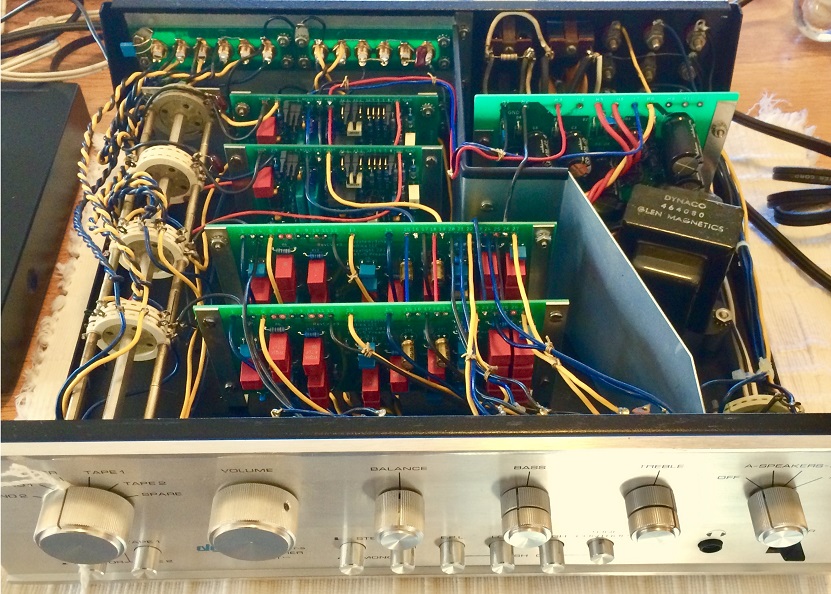
Jon's PAT-5 with update/improved power supply, line stage, and phono stage.
As we mentioned above, in their stock condition, PAT-5 preamps are perpetually powered. Yes...there's a power switch, but it only controls the convenience outlets. The preamp circuits are always on! Dynaco changed to the always-on power wiring shortly after the PAT-5 was introduced. It was the cheapest way to avoid power up and power down pulses. Unchecked, these pulses, passed through a 200 Watt per-channel amplifier like the Stereo 400, could turn woofers into toast.
Take a look at the PAT5PM Relay muting kit. It lets you turn preamp power on and off, and prevents problems with start up/shut down transients.
Equally interesting, and little known, Dynaco made a similar add-on board. Tony H. had a copy in his files, and has graciously allowed me to post it here.
This new, improved power supply has dramatically lower noise and dramatically better regulation. You can order it here.
Here's the Rev B assembly manual
Here's the Rev D assembly manual
Here's the Rev E assembly manual. It started shipping in August of 2018, and delivers the extra plus/minus 15 volts needed if you are installing both the line stage upgrade and the phono preamp upgrade.
You can see the Rev B schematic here.
You can see the Rev D schematic here.
Here are the specs:
These specs are more than 10 times better than those for the original power supply. Better power for better sound. Download the assembly manual for more detailed data.
Dirty, corroded jacks make bad connections, causing noise and distortion. You can beautify your PAT-5 and improve its sound when you replace the jacks with this kit.
As PAT-5's age, the electrolytic capacitors on the line stage board lose capacitance. This can make a channel go silent, or just put a kink in the bass. Yes, you could do a cap replacement, but you could do better.
We've made a redesigned PAT-5 line stage that just drops in, replacing and upgrading the original line stages. The new boards have:
We think you'll really enjoy building the kit and listening to its sound. You can buy it here, in the Updatemydynaco store.
If you like experimenting with different opamps, you can also buy gold-plated sockets and a couple different types of opamps for experiments, but the basic kit comes with NE5532 opamps. These opamps are used the world over in recording consoles, and have a well-deserved reputation for both great sound and value.
One of my customers, Michael, was kind enough to take the time to report on his listening tests:
This is the listening system:
I hooked up the PAT-5 without the cover (just in case) and plugged in the turn table. Volume all the way down (just in case) and as I raised the volume, nothing happened...all the way up. Turned it down, unplugged the PAT-5 power, and sat very dejected. Then I realized that I needed to plug the PAT-5 into the ST-70 [DUH]...who's excited? On the next attempt, everything worked perfectly. The new attenuator calibrates volume setting exactly at 12 for my usual listening level for the usual albums. (Editor's note: The Soundsmith Cartridge and preamp combination has a very high output level, so we put together a two-resistor attenuator to return the PAT-5's volume control to a sweet spot when the external phono preamp was selected). This gets me into a range that is easier to make smaller adjustments. THANK YOU!!
Here are my comments and thoughts. There is significantly less hum with the new PS. There is improved clarity and what sounds like more open highs and tighter bass. The sound stage is deeper and wider. The first lp was Pictures at an Exhibition, original Living Stereo: I felt like I was walking through the Rijksmuseum. The next album was a new reissue of Nina Simone's Little Girl Blue; phenomenal transparency and her voice and the instruments were perfectly placed across the stage. Then Kind of Blue, where I heard new info even after all those many previous hearings. Waltz for Debby followed and I heard clarity of the wood resonance of LaFarro's bass like this was a new piece of music. This went on with Mahler 1 & 5, Shostakovich 3, Beethoven String Quartet op. 131, Burning Spear, Santana, Stones, Beatles, etc, etc, etc.
MY EARS ARE SMILING!! Thank you for your patience with me, for answering questions, acting as a teacher would by providing explanations, and tolerating klutziness.
In a subsequent listening session,My audiophile friend and I spent 7 hours last night listening to a variety of rock, jazz and blues. And he really liked the change to the sound with the three upgrades to the PAT-5. He compared it to when he upgraded his processor to a pre-amp and said the sound was as good as his rig. (His rig is VPI, Lyra cartridge, all Krell electronics and B&W 802s.) As I said before, this is the cleanest, most transparent sound I have heard yet. I continue to discover new sounds on old recordings that I have been listening to since 1959. I could not be happier. Thank you again for your knowledge and advice.
All the best,
Michael
If you're just keeping your original line-stage PCBs, the opamp used in the high level stage can be significantly improved. You can replace it with TI's LME49710, which is available in the 8-lead round metal can package as of November 2015, though there are rumors that the package will be discontinued. If you make this modification:
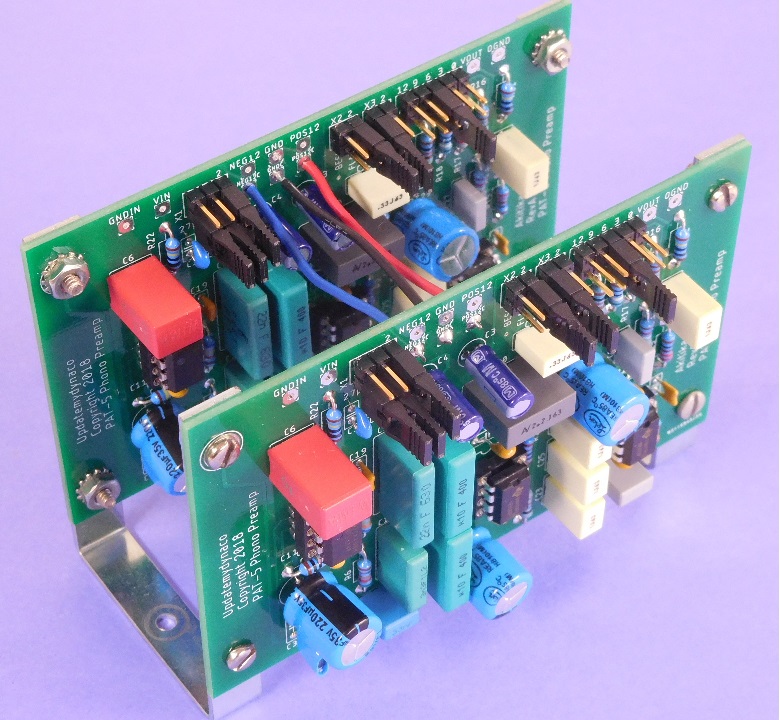
The PHONOZ preamp for the PR-101 has garnered world-wide acclaim for its low noise, accurate equalization, and great sound. We've now brought that design to the PAT-5, in a beautiful dual-mono implemenation. It retains all the flexibility of the PHONZ, with selectable gain (3 dB steps from 30 to 42 dB at 1 kHz), and selectable high-pass filters (four combinations of Bessel and single pole filters) for the ultimate in rumble and low frequency noise rejection while preserving the low frequency musical energy.
This phono preamp upgrade gives the PAT-5 a world class phono preamp that is quieter than you would have believed possible. Oh, and we almost forgot, you can also select the capacitive loading on your cartridge to get the best sound possible from your records.
Please note that to support the PAT5PHONO, you'll need to upgrade your power supply to PAT5PWR Rev E or later.
Want more information? You can download the assembly manual here.
You can order the PAT5PHONO kit here.
A customer, Brian, wanted to do just what the title said. Why? Batteries don't hum! Also...he thought it would be fun...and he reports that it was. After a little back and forth, we concluded that he was a visual guy, so we made the following picture to show the wiring
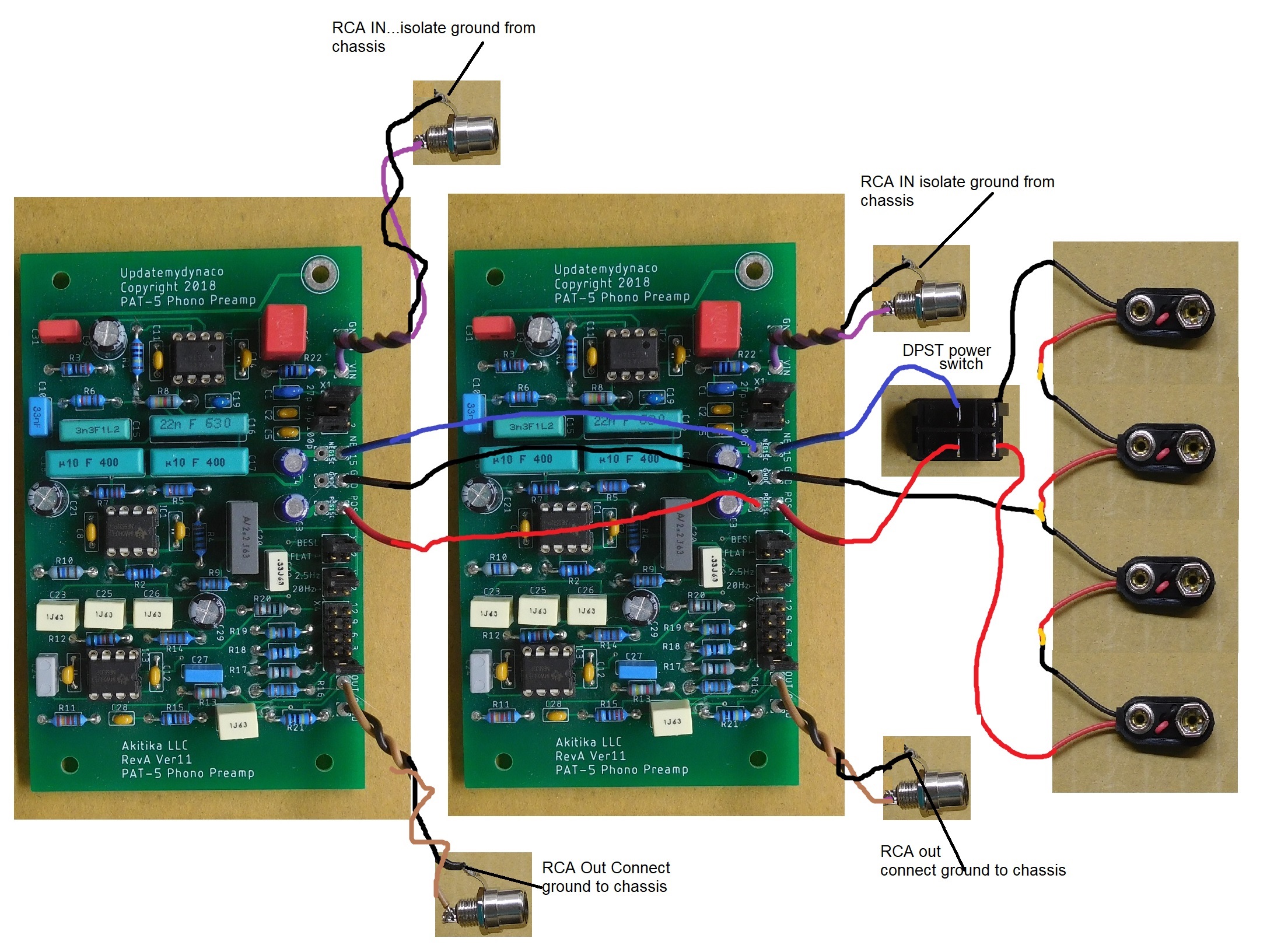
The enclosure he built was a bit unusual. Here's a picture:
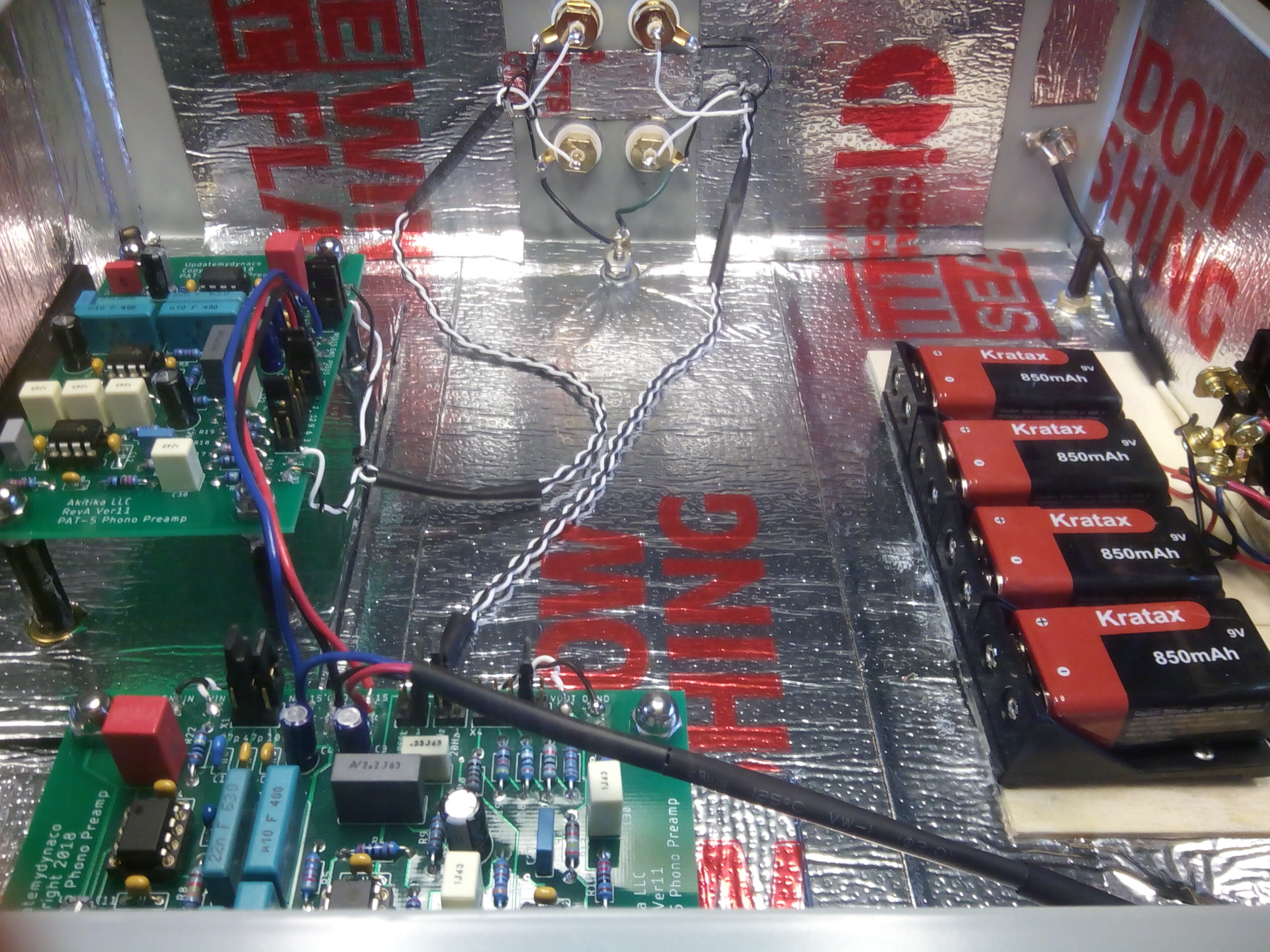
And here's Brian's impression of his results:
Hi Dan,
Your Pat-5 phono preamp is very, very musical with holograph imaging. I have a lot of fun near field listening to the speakers. It is like listening to headphones...only better. Zero noise. Much inner detail. The silver color surface inside the steel chassis is roof window flashing from Lowes store. It works like Dynamat to stop vibrations only it is less costly for a roll. The removable 12"X 12" chassis lid is also coated with it. After listening for 5 hours to the Pat-5 phono preamp with rechargeable 9v 850 mAh Lithium-ion batteries the board voltage is 15.77v on the minus side and 15.40v on the plus side. Gain is set at 3db, load is 47k, and equalization is flat.
I recently re-did a PAT-5. Actually, a friend installed the PAT5PWR kit and the PAT5 Replacement Jacks. At that point, he said, "It still sounded like it was playing underwater". We arranged a credit on a PR-101, and I got a PAT-5 to dig into. Here's what I found:
So, to get this PAT-5 back to sounding great, I did the following:
The result is a nice sounding, smooth operating preamp...pretty quiet, though not as good as a PR-101, but certainly not bad. I checked the equalization of the phono preamp, and it had good square wave response, indicating that the equalization was pretty close.
Still on the to-do list:
Do you ever use the LOW filter? Its job, when activated, is to filter out some of the low frequencies. It may be useful if your source has a lot of hum or low frequency noise. I can probably count the number of times I have used the switch on the fingers of one hand. You can change its function to something that may be rather more useful.
You can change the LOW filter to a 20 dB attenuator. Here how it's useful:
Converting your LOW filter to a 20 dB attenuator is easy. You'll just swap two capacitors for two 100K Ohm resistors as shown in this picture. The resistors could be anything in the neighborhood of 100K, plus or minus 10%. However, they should be matched pairs. 1/4 Watt metal film resistors would do just fine.
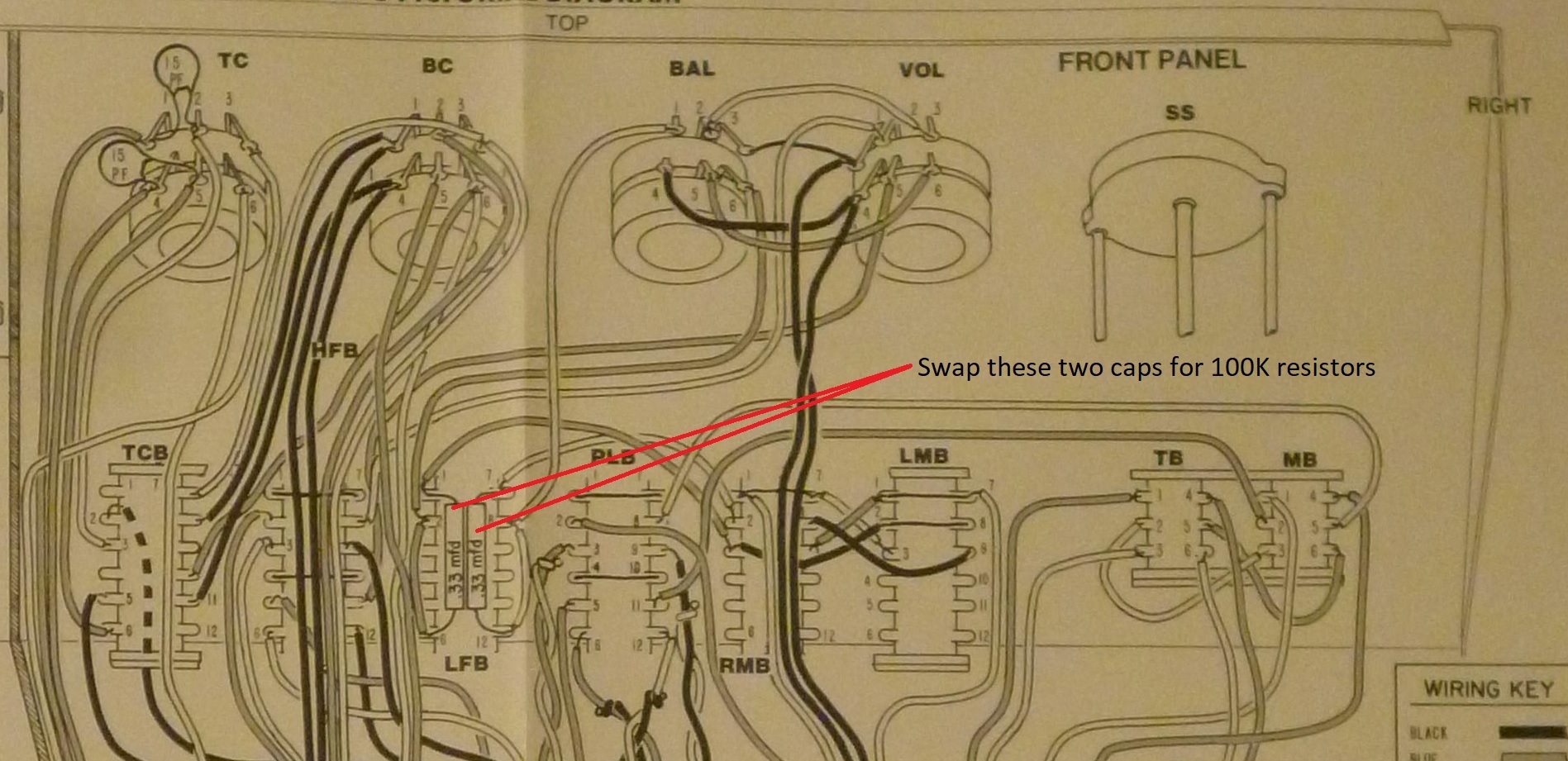
If your balance control has seized, or is otherwise beyond repair, you'll be looking for a replacement. Well, the original pot had a custom taper that is currently not available. This document shows a way to approximate the original performance and action using currently available parts.
A kit of these parts is available at the Updatemydynaco store.
If your volume control has seized, or is otherwise beyond repair, you'll be looking for a replacement. Well, the original pot had an audio tape, but a funny value (15K) that is currently not available. This document shows a way to approximate the original performance and action using currently available parts.